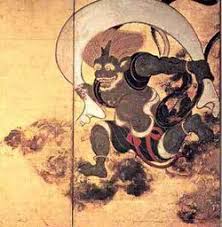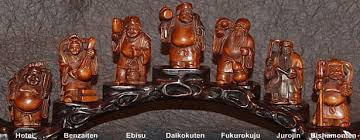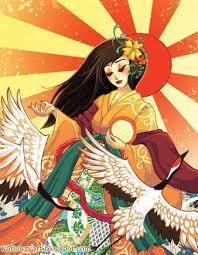List of Japanese deities
日本の神々のリスト
内容
1主な神
.jpg)
2マイナーカミ
.jpg)
3仏教
.jpg)
4人の幸運の神
.jpg)
Major kami (主要な神)
.jpg)
Amaterasu-Ō-Mi-Kami (天照大神 or 天照大御神) Commonly called Amaterasu, she is the goddess of the sun as well as the purported ancestress of the Imperial Household of Japan. Her full name means "Great Goddess" or "Great Spirit Who Shines in the Heavens"; she may also be referred to as Ōhiru-menomuchi-no-kami (大日孁貴神). For many reasons, one among them being her ties to the Imperial family, she is often considered (though not officially) to be the "primary god" of Shinto.
Ame-no-Uzume (天宇受売命 or 天鈿女命) Commonly called Uzume, she is the goddess of dawn and revelry, instrumental to the "missing sun motif" in Shinto.[citation needed] She is also known as The Great Persuader and The Heavenly Alarming Female.
Fūjin (風神) Also known as Kami-no-Kaze, he is the Japanese god of the wind and one of the eldest Shinto gods, said to have been present at the creation of the world. He is often depicted as an oni with a bag slung over his back.
Hachiman (八幡神) Also known as Hachiman-shin or Yawata no Kami, he is the god of war and the divine protector of Japan and its people. Originally an agricultural deity, he later became the guardian of the Minamoto clan. His symbolic animal and messenger is the dove.
Inari Ōkami (稲荷大神) The god or goddess of rice and fertility. Their messengers and symbolic animal are foxes. They are often identified with the Ukanomitama and Buddhist deity Dakiniten.
Izanagi (伊弊諾 or 伊邪那岐) The forefather of the gods, he is the first male as well as the god of creation and life. He and his wife, Izanami, were responsible for the birth of the islands of Japan and many kami, though she died in childbirth. Later, after his failed attempt to retrieve her from the underworld, he sired Amaterasu, Susanoo and Tsukuyomi.
Izanami (伊弉冉 or 伊邪那美) Izanagi's wife and sister, she is the first female as well as the goddess of creation and death. She died shortly after the birth of Kagu-tsuchi, and Izanagi followed her to the underworld, but failed to bring her back to the living world. A marital spat between the pair caused the cycle of life and death for all living beings.
Kuninotokotachi (国之常立神?, Kuninotokotachi-no-Kami, in Kojiki)(国常立尊?, Kuninotokotachi-no-Mikoto, in Nihonshoki) is one of the two gods born from "something like a reed that arose from the soil" when the earth was chaotic. In the Nihon Shoki, he is the first of the first three divinities born after heaven and earth were born out of chaos, and is born from something looking like a reed-shoot growing between heaven and earth. He is known by mythology to reside on top of Mount Fuji (富士山). Kuninotokotachi is described as a hitorigami and genderless in Kojiki, while as a male god in Nihon Shoki. Yoshida Kanetomo, the founder of the Yoshida Shintō sect, identified Kuninotokotachi with Amenominakanushi and regarded him as the primordial god of the Universe.
Ninigi-no-Mikoto (瓊瓊杵尊) Commonly called Ninigi, he was the grandson of Amaterasu. His great-grandson was Kan'yamato Iwarebiko, later to be known as Emperor Jimmu, first emperor of Japan.
Ōkuninushi (大国主) A god of nation-building, farming, business, and medicine.
Omoikane (思兼) The deity of wisdom and intelligence, who is always called upon to "ponder" and give good counsel in the deliberations of the heavenly deities.
Raijin (雷神) Commonly called Raiden (雷電), he is the god of thunder and lightning, and is often paired with Fūjin. As with the latter, Raijin is usually depicted as an oni.
Ryūjin (龍神) Also known as Ōwatatsumi, he is a dragon, as well as god of the sea. He resides in Ryūgū-jō, his palace under the sea built out of red and white coral, from where he controls the tides with magical tide jewels. His great-grandson would become Emperor Jimmu.
Suijin (水神) The God of Water.
Susanoo-no-Mikoto (須佐之男尊) Alternately romanized as Susano-o, Susa-no-o, and Susanowo. Reportedly called "Futsushi". He is the god of storms as well as in some cases the god of the sea. He is also somewhat of a trickster god, as Japanese mythology extensively documents the "sibling rivalry" between him and Amaterasu. Susanoo also was responsible for the slaying of the monster Yamata no Orochi and the subsequent discovery of the sacred sword Kusanagi.
Tenjin (天神) The god of scholarship, he is the deified Sugawara no Michizane (845–c903), who was elevated to his position after dying in exile and subsequent disasters in Heiankyo were attributed to his angered spirit.
Toyotama-hime (豊玉姫) Also known as Otohime (乙姫), she was the daughter of Ryūjin and the grandmother of Jimmu. It is said that after she gave birth to her son, she turned into a dragon and disappeared.
Tsukuyomi-no-Mikoto (月読の命 or 月夜見の尊) Also known as Tsukiyomi, Tsuki no Kami, Tsukiyomino Mikoto, and Tsukiyumi no Mikoto, he is the god of the moon. He killed the goddess of food, Uke Mochi, out of disgust and anger in the way she had prepared a meal. This caused Amaterasu to never face him again, causing the sun and moon to be in different parts of the sky.
Takemikazuchi, known as a god of thunder and the god of swords(剣の神).
Takeminakata
Minor kami(マイナーカミ)
.jpg)
Amatsu-Mikaboshi (天津甕星), the kami of stars who existed before the Kotoamatsukami. Mentioned under Takemikazuchi.
Ajisukitakahikone
Ame-no-hohi (天菩比神, 天穂日命)
Ame-no-Koyane (天児屋命 or 天児屋根命) A male deity, he is considered the "First in Charge of Divine Affairs", as well as the aide to the first Emperor of Japan.[1] He is also considered to be the ancestor of the Fujiwara family.
Ame-no-oshihomimi (天忍穂耳命)
Ame-no-wakahiko (天若日子, 天稚彦)
Azumi-no-isora (阿曇磯良) is a kami of the seashore. He is considered to be the ancestor of the Azumi people.
Futsunushi (経津主神) Main deity at Katori Shrine.
Iwai-nushi-no-kami (斎主尊), god name whose identity is obscure. Nihon shoki calls him Iwai-no-ushi (斎之大人) and locates him in Katori which suggest the god might be Futsunushi. But there is reason to believe he might be Takehazuchi (建葉槌命) (See Takemizuchi), and there are others who say this might even be Amaterasu.[2]Futsunushi (経津主神)
Isetsuhiko (伊勢都彦命)
Ishikori-dome no Mikoto (石凝姥命), god of metalworking.
Kagu-tsuchi is the kami of fire, and a patron of blacksmiths and potters.
Kotoshironushi
Kuebiko (久延毘古) god of knowledge and agriculture, represented in Japanese mythology as a scarecrow who cannot walk but has comprehensive awareness.
Kuraokami (闇龗), Okami (龗), or Okami no kami (淤加美神) is a legendary Japanese dragon and Shinto deity of rain and snow.
Kukurihime no Kami (菊理媛神), a goddess enshrined at Shirayama Hime Shrine.
Kōjin (三宝荒神), is the god of fire, the hearth, and the kitchen.
Konohanasakuya-hime (木花之開耶姫), the wife of Ninigi and daughter of Ōyamatsumi, and great-grandmother of Jimmu. She is also known as the goddess of Mount Fuji. She is also known by the name Sengen.
Moreya
Nigihayahi-no-mikoto (饒速日尊, 天照国照彦天火明櫛玉饒速日尊) reportedly called "Furu" and said a son of "Futsushi". Only Nigihayahi (Furu) has the name of "Amateru (天照)" among Japanese deities. It is clearly described that Nigihayahi was ruling Yamato (ancient name of the capital and the center of Japan) before conquest war of emperor Jinmu in the two oldest official history books of Japan, "Kojiki" (712) or "Nihon Shoki" (720). According to Nihon Ōdai Ichiran, Nigihayahi descended from the Heaven and was then served by and under the protection of Nagasunebiko, but after having been conquered, the relics Jingi brought by Nigihayahi as proof of his legitimacy were proven inferior to the mere bow and arrows of Emperor Jimmu. His descendants became thus the servants of the Imperial Dynasty.
Oda Nobunaga enshrined at Kenkun-jinja.
Omoikane (思兼神), god of wisdom and intelligence.
Ōyamatsumi (大山積神), an elder brother of Amaterasu, and an important god who rules mountain, sea, and war, as well as the father of Konohanasakuya-hime.
Sukuna-Biko-Na (少名毘古那) A small deity of medicine and rain, who created and solidified the land with Ōkuninushi.
Sarutahiko Ōkami (猿田毘古神), a kami of the Earth that guided Ninigi to the Japanese islands.
Shōtoku Taishi was sometimes worshipped by Shintoists in Prince's Hall (太子堂 Taishido) as the Kami of building trade and easy birth, like in the Hokai-ji of Kamakura.
Seidai Myōjin, god of sports, enshrined at Shiramine Shrine in Kyoto, especially worshipped for Kemari and Football.
Satimasuma (天苗加命) reportedly called "Futsushi" and said a son or elder brother of "Futsu".
Tajimamori (田道間守), god who obtained the tokijiku no kagu no mi in Tokoyo-no-kuni, and hailed as "god of wagashi" (sweets, confections).
Tōshō Daigongen (Tokugawa Ieyasu) enshrined at Nikkō Tōshō-gū and similar shrines.
Toyotomi Hideyoshi enshrined at Toyokuni-jinja.
Ugajin, a harvest and fertility kami represented with the body of a snake and head of a man or woman. S/he may be derived from Ukanomitama.
Ukanomitama, "the spirit of rice in storehouses", a kami associated with food and agriculture.
Uke Mochi (保食神), sometimes called Ogetsu-hime-no-Kami, a goddess of food. After she had spat a fish, vomited or defecated game and coughed rice, she had been killed by a disgusted Tsukuyomi, or in some other versions, Susanoo.
Yama-no-kami are a group of mountain deities, usually represented as female.
Buddhism
.jpg)
Further information: Japanese Buddhist pantheon
Aizen Myō-ō (愛染明王), a Wisdom King known to transform earthly desires (love/lust) into spiritual awakening.
Amida Nyorai (無量光佛 or 無量壽佛), commonly referred to as Amida-butsu (阿弥陀如来), he is the primary Buddha of the Pure Land school of Buddhism. He is believed to possess infinite meritorious qualities, and is known as the "Lord of the Beyond and the Afterlife". He is one of the Five Dhyani Buddhas.
Daruma (ダルマ), traditionally held in Buddhist mythology to be the founder of Zen Buddhism, as well as the founder of Shaolin Kung Fu. One legend reports that after years of facing a wall in meditation, Bodhidharma's legs and arms fall off due to atrophy. Daruma dolls were created in honor of this legend.
Fudō Myōō (不動明王), a fierce and wrathful Wisdom King who protects all by burning away impediments and defilements, and aiding them towards enlightenment.
Idaten (韋駄天), guardian of Buddhist monasteries and monks.
Jizō (地蔵), a Bodhisattva known as the protector of the vulnerable, especially children, travelers, and expectant mothers. He is also regarded as the patron deity of deceased children and aborted fetuses, and the savior of hell-beings. His statues are a common sight, especially by roadsides and in graveyards.
Kangiten, god (deva) of bliss.
Kannon (観音), a Bodhisattva associated with compassion. Commonly known in English as the "Goddess of Mercy".
Yakushi Nyorai (薬師如来), a Buddha known for healing and medicine.
Seven Lucky Gods
.jpg)
Main article: Seven Lucky Gods
The Seven Lucky Gods (七福神 Shichi Fukujin) are:
.jpg)
Benzaiten (弁才天 or 弁財天) Also known as Benten or Benzaitennyo, she is the goddess of everything that flows: words (and knowledge, by extension), speech, eloquence, and music. Said to be the third daughter of the dragon-king of Munetsuchi, over the course of years she has gone from being a protective deity of Japan to one who bestows good fortune upon the state and its people. Derived from Saraswati, the equivalent Hindu goddess.[citation needed]
Bishamonten (毘沙門天) Also called Bishamon or Tamonten, he is the god of fortunate warriors and guards, as well as the punisher of criminals. Said to live halfway down the side of Mount Sumeru, the small pagoda he carries symbolizes the divine treasure house that he both guards and gives away its contents.
Daikokuten (大黒天) Often shortened to simply Daikoku, he is variously considered to be the god of wealth (more specifically, the harvest), or of the household (particularly the kitchen). He is recognised by his wide face, smile, and flat black hat. He is often portrayed holding a golden mallet, seated on bales of rice, with mice nearby (which signify plentiful food).
Ebisu (恵比須, 恵比寿, 夷 or 戎) The sole member of the gods believed to have originated in Japan, he was originally known as Hiruko (蛭子), the first child of Izanagi and Izanami. Said to be born without bones, he eventually overcame his handicaps to become the mirthful and auspicious Ebisu (hence one of his titles, "The Laughing God"). He is often depicted holding a rod and a large red sea bream or sea bass. Jellyfish are also associated with this god and the fugu restaurants of Japan will often incorporate Yebisu in their motif.
Fukurokuju (福禄寿) Often confused with Jurōjin, he is the god of wisdom and longevity and said to be an incarnation of the Southern Polestar. He is a star god accompanied by a crane and a turtle, which are considered to be symbols of longevity, and also sometimes accompanied by a black deer. The sacred book tied to his staff is said to contain the lifespan of every person on Earth.
Hotei (布袋) Best known in the Western world as the Laughing Buddha, Hotei is likely the most popular of the gods. His image graces many temples, restaurants, and amulets. Originally based on a Chinese Chan monk, Hotei has become a deity of contentment and abundance.
Jurōjin (寿老人) Also known as Gama, he represents longevity. He is often seen with a fan and a stave, and accompanied by a black deer.
The goddess Kichijōten (吉祥天), also known as Kisshoutennyo, is sometimes considered to be one of the seven gods,[3] replacing either Jurōjin or Fukurokuju.[4] She embodies happiness, fertility, and beauty. Daikoku sometimes manifests as a female known as Daikokunyo (大黒女) or Daikokutennyo (大黒天女).[5] When Kisshoutennyo is counted among the seven Fukujin[4] and Daikoku is regarded in feminine form,[5] all three of the Hindu Tridevi goddesses are represented in the Fukujin.